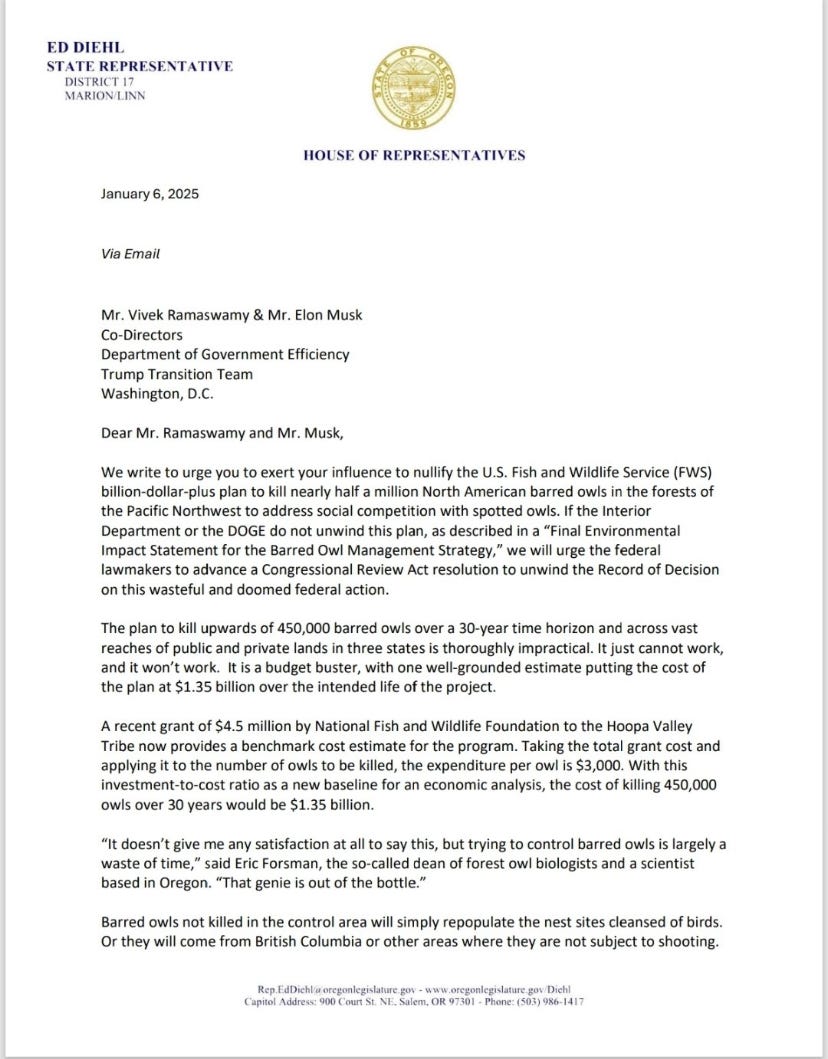The state of Oregon is one of the greenest states in all of the US. With 24% percent of it’s land surface covered in forests. Consisting of 30 native coniferous species and 37 native species of broadleaf trees. Home to a multitude of mammals, as well as large and small aviary species. Welcoming tourists from all over the world on an average of a little over a million people per year.

Putting into question, whether it is up to the partisan government to administer solutions, oftentimes gruesome, to prevent what some organizations call, biological processes.
In recent years, a wildlife management effort in the region has been the topic of debate amongst forestry and wildlife groups. The cull of the Barred Owl. What proponents call an invasive species to the region. By encroaching onto new land, it may be threatening the survival of the Spotted Owl. Both species of Owl have been actively seen in the region since the 1970’s. While the Barred Owl is considered native to Eastern North America, it is believed that the owl migrated naturally.
Those in support of the Barred Owl cull, claim that it is inhibiting the growth of the Spotted Owl. Competing for food, and territory. The Spotted Owl tends to reside in older forest regions and needs a little more territorial space to nest. While the Barred Owl, can survive in both old as well as newer forests, has off spring at faster rates and is overall slightly stronger.

Please listen here, to the sound of a Barred Owl hoot.
In 2024, the Biden administrations “America the Beautiful” grant program awarded the Hoopa Valley Tribe 4.5 million dollars to hunt down and kill as many as half a million individual owls over the course of ten years. After an approval process conducted by the US Fish and Wildlife service.
“What a colossal waste of life and money” said Wayne Pacelle, president of Animal Wellness Action and the Center for a Humane Economy.
In 2015, A Biologist with the Hoopa Tribal Forestry Agency, Mike Higley says, that illegal marijuana cultivators are known to spray rodenticide liberally, discard containers haphazardly and often quite simply leave poisoned bait to prevent wildlife from wondering onto their grounds. Stating that when testing the livers of found owls more than 60% indicate being poisoned fatally. Is it possible that there are other contributors to the decrease of certain local bird species?
Today, the Barred Owl is described as invasive. But, the characteristics of an invasive species are defined as non native threats to human, animal or environmental health. Examples of this include the lantern fly that New Yorkers have recalled in the past few years.
The barred owl seems to thrive in similar conditions as the spotted owl. They eat the same things and have no additional territorial conflicts. Other than what is sometimes known as gene swamping.
The process by which one branch of a species merge with another and the dominant traits of which present in the later. Over 240 scientistic organizations call this, nature.
Advocacy groups, call for the preservation of this subspecies as a federal responsibility to distinguish and preserve particular characteristics of any one species. Noting that a cull of this sort, would give the Spotted Owls an opportunity to recover their numbers. Though some argue that the method to preserve those characteristics shouldn’t be to slaughter the dominant trait carrier. Particularly, because those traits are the very ones that are ensuring the raptors survival.
On average, the barred owl is a few inches larger and has a slightly wider range of habitat tolerance. Some aviary enthusiasts might say that these owls are more than cousins, and are practically the same owl simply adapting to their environment.
Why then, the high price bounty on each owl?
This week, Oregon state representative Ed Diehl urged a congressional review, drafting a letter to the Department of Government Efficiency, or DOGE.
“A recent grant of $4.5 million by National Fish and Wildlife Foundation to the Hoopa Valley Tribe now provides a benchmark cost estimate for the program. Taking the total grant cost and applying it to the number of owls to be killed, the expenditure per owl is $3,000. With this investment-to-cost ratio as a new baseline for an economic analysis, the cost of killing 450,000 owls over 30 years would be $1.35 billion.”
Suggesting that this new policy will set into motion an indefinite cull.
The new temporary agency erected by the Trump administration to advise on federal misspending, DOGE, is set to expire in July of 2026. It is uncertain whether this large spend will be reviewed by the agency.
The Spotted Owls and the Barred Owls get along just fine. In fact, the two often hybridize. contributing to the possibility of ambiguous outcomes of such a drastic management strategy. Unlike other controversial government culling programs, this one is designed to prevent what appears to be a species of birds improving their own adaptability.
By going forward with this effort, the likelihood of preserving the traits of the Spotted Owl is increased by a whopping 10%. While abysmal amounts of money are being transferred from one organization to another. Offering uncertain benefits.
Animal rights groups are divided on this topic, but the Department of Government Efficiency may be the temporary answer to aborting the initiative.





